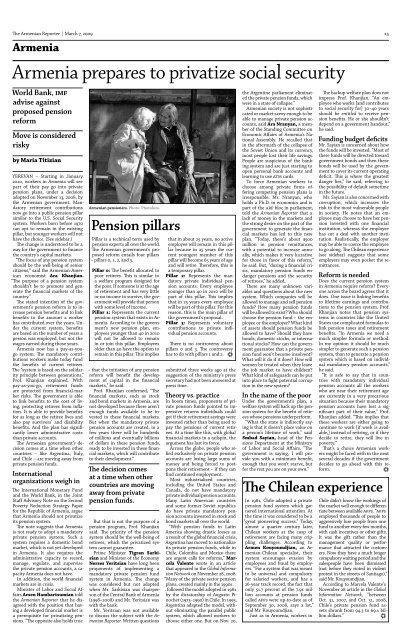National, International, Armenia, and Community News and Opinion
National, International, Armenia, and Community News and Opinion
National, International, Armenia, and Community News and Opinion
Create successful ePaper yourself
Turn your PDF publications into a flip-book with our unique Google optimized e-Paper software.
The <strong>Armenia</strong>n Reporter | March 7, 2009 15<br />
<strong>Armenia</strong><br />
<strong>Armenia</strong> prepares to privatize social security<br />
World Bank, IMF<br />
advise against<br />
proposed pension<br />
reform<br />
Move is considered<br />
risky<br />
by Maria Titizian<br />
YEREVAN – Starting in January<br />
2010, workers in <strong>Armenia</strong> will see<br />
part of their pay go into private<br />
pension plans, under a decision<br />
adopted on November 13, 2008, by<br />
the <strong>Armenia</strong>n government. M<strong>and</strong>atory<br />
retirement contributions<br />
now go into a public pension pillar<br />
similar to the U.S. Social Security<br />
system. Workers born before 1970<br />
can opt to remain in the existing<br />
pillar, but younger workers will not<br />
have the choice. (See sidebar.)<br />
The change is understood to be a<br />
way for the government to finance<br />
the country’s capital markets.<br />
“The focus of any pension system<br />
should be the well-being of senior<br />
citizens,” said the <strong>Armenia</strong>n-American<br />
economist Ara Khanjian.<br />
“The purpose of a pension system<br />
shouldn’t be to promote <strong>and</strong> generate<br />
the financial markets of the<br />
country.”<br />
The stated intention of the government’s<br />
pension reform is to increase<br />
pension benefits <strong>and</strong> to link<br />
benefits to the amount a worker<br />
has contributed over the years. Under<br />
the current system, benefits<br />
are based on the number of years a<br />
person was employed, but not the<br />
wages earned during those years.<br />
<strong>Armenia</strong> now has a pay-as-yougo<br />
system. The m<strong>and</strong>atory contributions<br />
workers make today fund<br />
the benefits of current retirees.<br />
The “system is based on the solidarity<br />
principle between generations,”<br />
Prof. Khanjian explained. With<br />
pay-as-you-go, retirement funds<br />
are protected from financial-market<br />
risks. The government is able<br />
to link benefits to the cost of living,<br />
protecting retirees from inflation.<br />
It is able to provide benefits<br />
for as long as the retiree lives <strong>and</strong><br />
also pay survivors’ <strong>and</strong> disability<br />
benefits. And the plan has significantly<br />
lower administrative costs<br />
than private accounts.<br />
The <strong>Armenia</strong>n government’s decision<br />
comes at a time when other<br />
countries – like Argentina, Italy,<br />
<strong>and</strong> Chile – are moving away from<br />
private pension funds.<br />
<strong>International</strong><br />
organizations weigh in<br />
The <strong>International</strong> Monetary Fund<br />
<strong>and</strong> the World Bank, in the Joint<br />
Staff Advisory Note on the Second<br />
Poverty Reduction Strategy Paper<br />
for the Republic of <strong>Armenia</strong>, argue<br />
that <strong>Armenia</strong> should not privatize<br />
its pension system.<br />
The note suggests that <strong>Armenia</strong><br />
is not ready to adopt a m<strong>and</strong>atory<br />
private pension system. Such a<br />
system requires a domestic bond<br />
market, which is not yet developed<br />
in <strong>Armenia</strong>. It also requires the<br />
administrative capacity to record,<br />
manage, regulate, <strong>and</strong> supervise<br />
the private pension accounts, a capacity<br />
<strong>Armenia</strong> does not have.<br />
In addition, the world financial<br />
markets are in crisis.<br />
Minister of Labor <strong>and</strong> Social Affairs<br />
Arsen Hambartsumian told<br />
the <strong>Armenia</strong>n Reporter that he disagreed<br />
with the position that having<br />
a developed financial market is<br />
a prerequisite for privatizing pensions.<br />
“The opposite also holds true<br />
<strong>Armenia</strong>n pensioners. Photo: Photolure.<br />
Pension pillars<br />
Pillar is a technical term used by<br />
pension experts all over the world.<br />
The <strong>Armenia</strong>n government’s proposed<br />
reform entails four pillars<br />
– pillars 0, 1, 2, <strong>and</strong> 3.<br />
Pillar 0: The benefit allocated to<br />
poor retirees. This is similar to<br />
a welfare program designed for<br />
the poor. If someone is at the age<br />
of retirement <strong>and</strong> has very little<br />
or no income to survive, the government<br />
will provide that person<br />
with some level of income.<br />
Pillar 1: Represents the current<br />
pension system that exists in <strong>Armenia</strong>.<br />
According to the government’s<br />
new pension plan, employees<br />
younger than 40 in 2010<br />
will not be allowed to remain<br />
in or join this pillar. Employees<br />
older than 40 have the option to<br />
remain in this pillar. This implies<br />
– that the initiation of any pension<br />
reform will benefit the development<br />
of capital in the financial<br />
markets,” he said.<br />
Prof. Khanjian confirmed, “The<br />
financial markets, such as stock<br />
<strong>and</strong> bond markets in <strong>Armenia</strong>, are<br />
not developed because there aren’t<br />
enough funds available to be invested<br />
in these financial markets.<br />
But when the m<strong>and</strong>atory private<br />
pension accounts are created, in a<br />
few years there will be hundreds<br />
of millions <strong>and</strong> eventually billions<br />
of dollars in these pension funds,<br />
ready to be invested in these financial<br />
markets, which will contribute<br />
to their development.”<br />
The decision comes<br />
at a time when other<br />
countries are moving<br />
away from private<br />
pension funds.<br />
But that is not the purpose of a<br />
pension program, Prof. Khanjian<br />
said. The priority of the pension<br />
system should be the well-being of<br />
retirees, which the privatized system<br />
cannot guarantee.<br />
Prime Minister Tigran Sarkisian<br />
<strong>and</strong> Minister of the Economy<br />
Nerses Yeritsian have long been<br />
proponents of implementing a<br />
m<strong>and</strong>atory private pension fund<br />
system in <strong>Armenia</strong>. The change<br />
was considered but not adopted<br />
when Mr. Sarkisian was chairperson<br />
of the Central Bank of <strong>Armenia</strong><br />
(1998–2008) <strong>and</strong> Mr. Yeritsian was<br />
with the bank.<br />
Mr. Yeritsian was not available<br />
to discuss the subject with the <strong>Armenia</strong>n<br />
Reporter. Written questions<br />
that in about 25 years, no active<br />
employee will remain in this pillar<br />
because in 25 years the current<br />
youngest member of this<br />
pillar will become 65 years of age<br />
<strong>and</strong> will retire. Therefore, this is<br />
a temporary pillar.<br />
Pillar 2: Represents the m<strong>and</strong>atory<br />
private individual pension<br />
accounts. Every employee<br />
younger than 40 in 2010 will be<br />
part of this pillar. This implies<br />
that in 25 years every employee<br />
will be part of this pillar. For this<br />
reason, this is the main pillar of<br />
the government’s proposal.<br />
Pillar 3: Represents voluntary<br />
contributions to private individual<br />
pension accounts.<br />
There is no controversy about<br />
pillars 0 <strong>and</strong> 3. The controversy<br />
has to do with pillars 1 <strong>and</strong> 2. f<br />
submitted three weeks ago at the<br />
suggestion of the ministry’s press<br />
secretary had not been answered at<br />
press time.<br />
Theory vs. practice<br />
In boom times, proponents of private<br />
pension funds pointed to impressive<br />
returns individuals could<br />
get if their retirement savings were<br />
invested rather than being used to<br />
pay the pensions of current retirees.<br />
At a time like this, with global<br />
financial markets in a tailspin, the<br />
argument has lost its force.<br />
Across the globe, people who relied<br />
exclusively on private pension<br />
accounts are losing large sums of<br />
money <strong>and</strong> being forced to postpone<br />
their retirement – if they can<br />
find continued employment.<br />
Most industrialized countries,<br />
including the United States <strong>and</strong><br />
Canada, do not have m<strong>and</strong>atory<br />
private individual pension accounts.<br />
Many Latin American countries<br />
<strong>and</strong> some former Soviet republics<br />
do have private m<strong>and</strong>atory pension<br />
accounts invested in stock <strong>and</strong><br />
bond markets all over the world.<br />
“With pension funds in Latin<br />
America showing drastic losses as<br />
a result of the global financial crisis,<br />
Argentina has moved to nationalize<br />
its private pension funds, while in<br />
Chile, Colombia <strong>and</strong> Mexico there<br />
are urgent calls for reforms,” Marcela<br />
Valente wrote in an article<br />
that appeared in the Global Information<br />
Network on November 28, 2008.<br />
“Many of the private sector pension<br />
plans, created mainly in the 1990s . .<br />
. followed the model adopted in 1981<br />
by the dictatorship of Augusto Pinochet<br />
(1973–1990) in Chile. In 1993,<br />
Argentina adapted the model, without<br />
eliminating the parallel public<br />
system, which allowed workers to<br />
choose either one. But on Nov. 20,<br />
the Argentine parliament eliminated<br />
the private pension funds, which<br />
were in a state of collapse.”<br />
<strong>Armenia</strong>n society is not sophisticated<br />
or market savvy enough to be<br />
able to manage private pension accounts,<br />
said Ara Nranyan, a member<br />
of the St<strong>and</strong>ing Committee on<br />
Economic Affairs of <strong>Armenia</strong>’s <strong>National</strong><br />
Assembly. He recalled that<br />
in the aftermath of the collapse of<br />
the Soviet Union <strong>and</strong> its currency,<br />
most people lost their life savings.<br />
People are suspicious of the banking<br />
system <strong>and</strong> are just starting to<br />
open personal bank accounts <strong>and</strong><br />
learning to use ATM cards.<br />
To force <strong>Armenia</strong>n workers to<br />
choose among private firms offering<br />
competing pension plans is<br />
irresponsible. Mr. Nranyan, who<br />
holds a Ph.D. in economics <strong>and</strong> is<br />
part of the ARF bloc in parliament,<br />
told the <strong>Armenia</strong>n Reporter that a<br />
lack of money in the markets <strong>and</strong><br />
the strong desire on the part of the<br />
government to generate the financial<br />
markets has led to this new<br />
plan. “Today, there’s about $500<br />
million in pension remittances,<br />
with a potential to increase annually,<br />
which makes it very lucrative<br />
for those in favor of this reform,”<br />
he said. But, “during a financial crisis,<br />
m<strong>and</strong>atory pension funds endanger<br />
pensions <strong>and</strong> the security<br />
of retirees,” he added.<br />
There are many unknown variables<br />
<strong>and</strong> questions about the new<br />
system. Which companies will be<br />
allowed to manage <strong>and</strong> sell pension<br />
funds? How many pension funds<br />
will be allowed to exist? Who should<br />
choose the pension fund – the employee<br />
or the employer? What kind<br />
of assets should pension funds be<br />
allowed to have? Should they have<br />
bonds, domestic stocks, or international<br />
stocks? How can the government<br />
guarantee that a private pension<br />
fund won’t become insolvent?<br />
What will it do if it does? How will<br />
women be treated when they leave<br />
the job market to have children?<br />
What kind of safeguards can be put<br />
into place to fight potential corruption<br />
in the new system?<br />
In the name of the poor<br />
Under the government’s plan, a<br />
welfare system will back up the pension<br />
system for the benefit of retirees<br />
whose pensions underperform.<br />
“What the state is indirectly saying<br />
is that it doesn’t place value on<br />
a person’s lifetime of work,” said<br />
Smbad Sayian, head of the Pensions<br />
Department at the Ministry<br />
of Labor <strong>and</strong> Social Affairs. “The<br />
government is saying, I will provide<br />
you with a minimum benefit,<br />
enough that you won’t starve, but<br />
for the rest you are on your own.”<br />
In 1981, Chile adopted a private<br />
pension fund system which garnered<br />
international attention. At<br />
the time it was considered to be a<br />
“great pioneering success.” Today,<br />
almost a quarter century later,<br />
Chilean workers at the cusp of<br />
retirement are facing many crippling<br />
challenges. According to<br />
Armen Kouyoumdjian, an <strong>Armenia</strong>n-Chilean<br />
specialist, their<br />
system encourages evasion by<br />
employees <strong>and</strong> fraud by employers.<br />
“For a system that was meant<br />
to be universal <strong>and</strong> compulsory<br />
for salaried workers, <strong>and</strong> has a<br />
26-year track record, the fact that<br />
only 51.7 percent of the 7.91 million<br />
accounts at pension funds<br />
called AFPs were up-to-date as of<br />
September 30, 2008, says a lot,”<br />
said Mr. Kouyoumdjian.<br />
Just as in <strong>Armenia</strong>, workers in<br />
The backup welfare plan does not<br />
impress Prof. Khanjian. “An employee<br />
who works [<strong>and</strong> contributes<br />
to social security for] 30–40 years<br />
should be entitled to receive pension<br />
benefits. He or she shouldn’t<br />
depend on a government h<strong>and</strong>out,”<br />
he said.<br />
Funding budget deficits<br />
Mr. Sayian is concerned about how<br />
the funds will be invested. “Most of<br />
these funds will be directed toward<br />
government bonds <strong>and</strong> then these<br />
bonds will be used by the government<br />
to cover its current operating<br />
deficit. This is where the greatest<br />
danger lies,” he said, referring to<br />
the possibility of default sometime<br />
in the future.<br />
Mr. Sayian is also concerned with<br />
corruption, which increases the<br />
risk to the most vulnerable people<br />
in society. He notes that an employee<br />
may choose to have her pension<br />
invested with one financial<br />
institution, whereas the employee<br />
has cut a deal with another institution.<br />
Realistically, the employer<br />
may be able to coerce the employee<br />
to go along. The Chilean experience<br />
(see sidebar) suggests that some<br />
employers may even pocket the remittances.<br />
Reform is needed<br />
Does the current pension system<br />
in <strong>Armenia</strong> require reform? Everyone<br />
across the board agrees that it<br />
does. One issue is linking benefits<br />
to lifetime earnings <strong>and</strong> contributions<br />
to the pension system. Prof.<br />
Khanjian notes that pension systems<br />
in countries like the United<br />
States use complicated formulas to<br />
link pension taxes <strong>and</strong> retirement<br />
benefits. “In <strong>Armenia</strong> we need a<br />
much simpler formula or method.<br />
In my opinion it should be much<br />
simpler to generate such a pension<br />
system, than to generate a pension<br />
system which is based on individual<br />
m<strong>and</strong>atory pension accounts,”<br />
he said.<br />
“It is safe to say that in countries<br />
with m<strong>and</strong>atory individual<br />
pension accounts all the workers<br />
who are near their retirement age<br />
are currently in a very precarious<br />
situation because their m<strong>and</strong>atory<br />
pension accounts have lost a significant<br />
part of their value,” Prof.<br />
Khanjian added. “This implies that<br />
these workers are either going to<br />
continue to work [if work is available,]<br />
instead of retiring, or if they<br />
decide to retire, they will live in<br />
poverty.”<br />
That’s a choice <strong>Armenia</strong>n workers<br />
might be faced with in the next<br />
several decades if the government<br />
decides to go ahead with this reform.<br />
f<br />
The Chilean experience<br />
Chile didn’t know the workings of<br />
the market well enough to differentiate<br />
between available AFPs. “AFPs<br />
employed thous<strong>and</strong>s of people to<br />
aggressively lure people from one<br />
fund to another every few months,<br />
with cash incentives or other gifts.<br />
It was the gift rather than the<br />
management quality or performance<br />
that attracted the customers.<br />
Now they have a much longer<br />
compulsory waiting period <strong>and</strong> the<br />
salespeople have been dismissed<br />
(not before they rioted in violent<br />
protest in the streets of Santiago),”<br />
said Mr. Kouyoumdjian.<br />
According to Marcela Valente’s<br />
November 28 article in the Global<br />
Information Network, “between<br />
Oct. 31, 2007, <strong>and</strong> Oct. 31, 2008,<br />
Chile’s private pension fund assets<br />
shrank from 94.3 to 69.1 billion<br />
dollars.”<br />
f

















